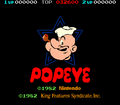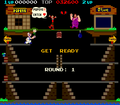(→Story) |
(Undo revision 394677 by 201.116.249.120 (Talk) see further text) |
||
| Line 21: | Line 21: | ||
==Story== | ==Story== | ||
It's the classic Popeye story. Olive Oyl is the love of Popeye's life, but Brutus has other plans in mind. Prove your love to Olive by capturing her heart(s), listening to her musical notes, and hearing her cries for help as you avoid | It's the classic Popeye story. Olive Oyl is the love of Popeye's life, but Brutus has other plans in mind. Prove your love to Olive by capturing her heart(s), listening to her musical notes, and hearing her cries for help as you avoid Brutus through three stages. Turn the tables on Brutus every once in a while by grabbing that can of spinach, but beware of the wicked Sea Hag. | ||
Due to an incorrect belief that Paramount Pictures owned the rights to the "Bluto" name, the character was changed to "Brutus" for the cartoon series after 1957, and wasn't changed back to Bluto until the [[1978]] Hanna-Barbera series. Despite the name returning to Bluto four years earlier, Nintendo kept the Brutus moniker for the arcade game. | Due to an incorrect belief that Paramount Pictures owned the rights to the "Bluto" name, the character was changed to "Brutus" for the cartoon series after 1957, and wasn't changed back to Bluto until the [[1978]] Hanna-Barbera series. Despite the name returning to Bluto four years earlier, Nintendo kept the Brutus moniker for the arcade game. | ||
Revision as of 00:36, 20 May 2009
Popeye arrived in the arcades in 1982. Like all of Nintendo's early arcade hits, this game was designed by Shigeru Miyamoto. Nintendo's acquisition of the Popeye license was rumored to have coincided with the motion picture release of Popeye staring Robin Williams as the title character. Though it is not unusual in this day and age for a game to be based on a license, it was a rarer sight in the early 80s. Regardless of your impression of Popeye, chances are you will find this game as enjoyable and challenging as Donkey Kong and Donkey Kong Jr..
Technologically, the arcade game uses a technique that was popularized by a few Bally Midway games which mixed high resolution foreground sprites with low resolution background displays. This resulted in extremely sharp and detailed graphics for the main characters, and contributed to its success. It also made the graphics difficult, if not impossible, to convert for home systems without a tremendous amount of compromise.
In 1982, Parker Brothers was determined to become a major player in the video game industry. As such, they joined the race with Atari, and later Coleco, to acquire the home conversion rights to several popular arcade hits. Along with Frogger and Q*Bert, they scored the rights to release Popeye for home systems and computers. In 1983, when Nintendo launched the Famicom in Japan, Popeye was one of the first three games made available for the system. Template:Continue Nav
Story
It's the classic Popeye story. Olive Oyl is the love of Popeye's life, but Brutus has other plans in mind. Prove your love to Olive by capturing her heart(s), listening to her musical notes, and hearing her cries for help as you avoid Brutus through three stages. Turn the tables on Brutus every once in a while by grabbing that can of spinach, but beware of the wicked Sea Hag.
Due to an incorrect belief that Paramount Pictures owned the rights to the "Bluto" name, the character was changed to "Brutus" for the cartoon series after 1957, and wasn't changed back to Bluto until the 1978 Hanna-Barbera series. Despite the name returning to Bluto four years earlier, Nintendo kept the Brutus moniker for the arcade game.
Table of Contents
-
Title screen
-
Game opening




